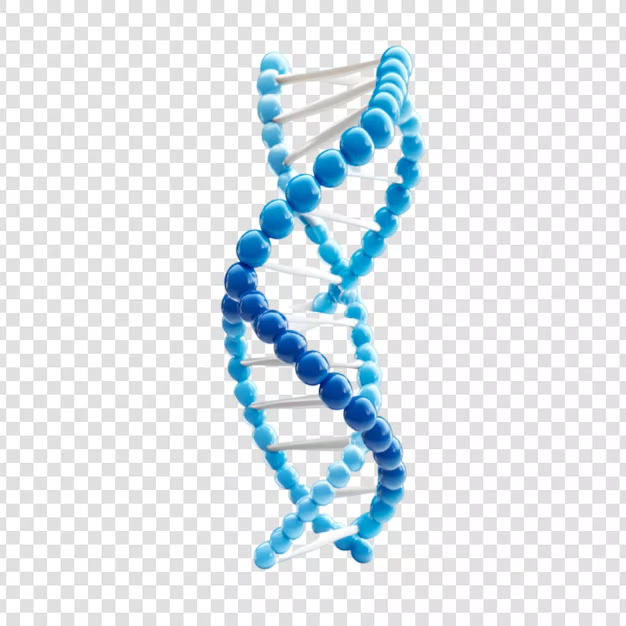




What is DNA Full Form?
DNA stands for Deoxyribonucleic Acid. It is a complex molecule that contains the genetic blueprint for living organisms. The name itself explains its structure: "Deoxy" refers to the absence of an oxygen atom in its sugar component, "Ribo" comes from ribose sugar, "Nucleic" indicates its presence in the cell nucleus, and "Acid" denotes its chemical nature.
DNA is important for storing and transmitting genetic information, ensuring that traits are passed from parents to offspring. It is made up of nucleotides arranged in a unique sequence, which determines the characteristics of an organism. DNA plays a vital role in biology, genetics, and medical research.
What is DNA?
DNA (Deoxyribonucleic Acid) is the molecule that carries the genetic instructions for all living organisms. It is found in the nucleus of cells and is made up of two strands twisted into a double helix. These strands are composed of nucleotides, which include four bases: Adenine (A), Thymine (T), Cytosine (C), and Guanine (G). The sequence of these bases determines genetic traits and guides the development, growth, and function of an organism.

DNA is responsible for passing genetic information from one generation to the next. It plays a crucial role in protein synthesis and cellular functions. Scientists study DNA to understand genetics, heredity, and medical advancements, making it essential for biology, medicine, and forensic science.
Different Types of DNA
DNA exists in various structural forms, each with unique properties and functions. The main types of DNA include:
Each type of DNA plays a crucial role in maintaining genetic information and regulating biological activities. B-DNA is essential for storing and transmitting genetic instructions, while Z-DNA influences gene expression. Mitochondrial DNA aids in energy production, and plasmid DNA provides genetic advantages like antibiotic resistance, supporting cellular survival and adaptation.
Structure of DNA
DNA (Deoxyribonucleic Acid) has a unique double-helix structure, discovered by James Watson and Francis Crick in 1953. This structure consists of:
Double Helix: DNA looks like a twisted ladder, with two strands coiled around each other.
Nucleotides: The building blocks of DNA, each containing a phosphate group, a sugar (deoxyribose), and a nitrogenous base.
Base Pairing: Four nitrogenous bases—Adenine (A), Thymine (T), Guanine (G), and Cytosine (C)—pair specifically (A-T, G-C) through hydrogen bonds.
Backbone: The sugar-phosphate backbone provides stability and structure.
Complementary Strands: Each strand serves as a template for replication, ensuring genetic continuity.
This structure allows DNA to store, replicate, and transmit genetic information across generations, making it essential for life.
Surprising Facts You Didn’t Know About DNA
Our DNA is 50 percent similar to cabbage
Even our human DNA isn’t all human
Only a few grams of DNA hold the capacity to store the entire world’s data
You can extract animal DNA from the air
Each person has approximately 20,000 to 25,000 genes, which account for only 1-2% of the total DNA.
Applications of DNA Technology
DNA technology has reformed various fields, from medicine to forensic science. In healthcare, it is used for genetic testing, disease diagnosis, and gene therapy to treat genetic disorders. Forensic science relies on DNA fingerprinting to solve crimes and identify individuals. In agriculture, genetically modified (GM) crops are developed for better yield and disease resistance.
DNA sequencing helps in evolutionary studies and biodiversity conservation. Additionally, it plays a crucial role in paternity testing and ancestry research. These applications continue to expand, making DNA technology essential in modern science and medicine.
Functions of DNA
Genetic Information Storage – DNA carries the instructions needed for the growth, development, and functioning of all living organisms.
Protein Synthesis – It directs the production of proteins through transcription (mRNA formation) and translation (protein formation).
Heredity and Inheritance – DNA passes genetic traits from parents to offspring, ensuring the continuity of species.
Cell Regulation and Function – It controls cell activities by regulating gene expression and ensuring proper cellular processes.
Mutation and Evolution – DNA changes (mutations) contribute to genetic variation, driving evolution and adaptation over generations.
Conclusion
DNA is the foundation of life, carrying genetic instructions that define every living being. It plays an important role in heredity, protein synthesis, and evolution. Advancements in DNA technology have transformed medicine, forensics, and biotechnology. Understanding DNA helps us unlock genetic mysteries, leading the way for medical breakthroughs and scientific discoveries that shape our future.
NEET 2025 Study Material
Students can access the NEET Study Material from the table below:
FAQs on Full Form of DNA - Deoxyribonucleic Acid
1. What is the full form of DNA?
The full form of DNA is Deoxyribonucleic Acid.
2. What does DNA stand for?
DNA stands for Deoxyribonucleic Acid, which carries genetic information.
3. What is the role of DNA in living organisms?
DNA contains the instructions that determine how organisms grow, develop, and function.
4. Why is DNA important?
DNA is essential for heredity, cell function, and the transmission of genetic traits.
5. Where is DNA found in human cells?
DNA is primarily found in the nucleus of human cells, though small amounts are found in mitochondria.
6. What is the structure of DNA?
DNA is a double helix structure composed of two strands of nucleotides twisted around each other.
7. How is DNA used in genetic research?
DNA analysis helps in understanding genetic diseases, traits, and inheritance patterns.
8. Can DNA be modified?
Yes, DNA can be modified through techniques like gene editing (e.g., CRISPR-Cas9).
9. What is the difference between DNA and RNA?
DNA contains the genetic blueprint, while RNA is involved in protein synthesis based on DNA instructions.
10. How does DNA replicate?
DNA replication occurs when the two strands separate, and new nucleotides are added to form two identical DNA molecules.























